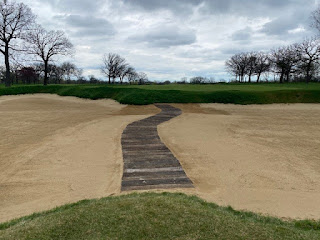*If viewing from your phone click “web version” at bottom to see videos. They don’t seem to show up on the phone view.
By and large, memberships take great pride in their clubs and I get asked by many of them "How can I help?" There are many things throughout a round membership can do to help with the playability, condition and overall showcasing of the golf course. These things include proper ball mark repair, proper divot replacement, divot patterns at the driving range tee, cart traffic patterns, and proper bunker raking. I'll discuss further in detail on each of these items and hopefully the membership will get a better idea of how each of these small things impact a golf course.
Ball Mark Repair
Our Greens are the crown jewel of the golf course and need to be as smooth and consistent as possible. Its no secret ball marks plague many greens and golf courses in general. Golf etiquette dictates its the responsibility of the golfer to fix and repair their own individual ball mark. However, there is a proper way to repair a ball mark that helps speed the recovery and cleans up the belemishes on the green. Here is a great video by the USGA on proper ball makr repair.
A key takeaway from the video is making sure you are not "popping the ball mark up" but stretching the turf together. This helps the turf heal quickly and gets rid of any bare spots that may effect ball roll. Any ball mark missed or improperly repaired will get shaved off with the greens mowers the following morning. Our staff does take time to quickly walk the Green prior to mowing each morning to look for unrepaired marks, however, we are typically mowing prior to sunrise and under time constraints, so it makes it difficult for us to repair the majority of ball marks that occur throughout a day. A properly repaired ball mark by a member goes along way in keeping the green surfaces smooth and looking good!
Divot Recovery/DRT Pattern
Understanding when to replace a divot and when to use the sand/seed to fill in the divot can will help in the time it takes the divots to recover. The ideal scenario is to replace your divot with the turf and stepping it down. When the divot stays together with soil and root structure it acts as a small piece of sod and the roots will take hold again, helping the divot heal quickly. 75% of the time this is the proper way to fill a divot at Beverly. When your divot has been disintegrated and there is no turf to put back, this is the time to fill the divot with sand. Sand is used to level the area and allow the bent grass to creep back in filling the divot. However, depending on the size of the divot, this process takes months to heal and make the divot disappear. So if there is a large divot that can be replaced, it makes a huge difference in recovery time if it is put back vs just filling with sand/seed.
One thing I find interesting, is in general, many golfers do not replace divots on a tee?? I find most golfers opt to fill in their large divots with sand. As stated above, sand is a much longer process to recovery vs replacing the divot, the same "rules" apply. So whether you're on a Tee or in the Fairway the best option is to always replace the divot when you can and only use the sand when there is no divot to replace. Here are a few videos from the USGA that discuss divot repair.
Note in the videos they mention divot patterns at the driving range and the proper pattern to use to help with quick recovery. This is extremely important to help preserve our range tee and for it to accommodate the large amount of use it sees. Here is a picture that illustrate proper divot pattern for the driving range tee.
In general it is very difficult for divots to heal and recover on the golf course due to our maintenance practices that focus on playability (fast/dry/firm) vs grow in/recovery (over water/high fertility/soft). Its especially difficult on the driving range tee due to the constant hitting and practicing. As a grounds staff, we don't have access to the driving range tee on regular basis throughout a day to be able to water and help with recovery. As a member a simple change in your hitting pattern can help in preserving our driving range tee throughout the season. Proper replacement of your divots on Tees and Fairways can he huge help in the quickness of their recovery as well.
Bunker Raking
The largest percentage of our labor budget goes to the maintenance of the bunkers. They see daily raking as well as work on checking sand depths, compacting sand and mowing the faces. Every golfer has there own preference in regards to the playability of the bunkers. In general, as a maintenance staff, our goal is to create consistent bunkers throughout the course, firm enough not to give "fried egg" lies, even depths and minimal contamination to the sand. We spend countless hours trying to create these conditions and while at times, we may fall short, due to multiple reasons, overall the bunkers are beginning to play better as the season/years progress.
One thing that can help in keeping the bunkers consistent and achieving those goals is proper bunker etiquette from the membership and caddies. Its important for the golfer to understand what we are trying to achieve and how neglect can cause the softening of spots or give a poor lie in a bunker. Here is a great video from the USGA on bunker etiquette and raking.
Cart Traffic Etiquette
As we get into season and cart traffic begins to pick up, its important to remind everyone of cart patterns throughout the course. Carts create major wear, tear and compaction throughout the course which in turn creates thinness in many areas. We have rope up throughout the course to help guide carts away from high profile areas. I would ask members operating a cart to please keep carts away from Greens, driving up into the approaches and up next to Tees. Please use cartpaths or park on cartpaths where they are avaialbe. Here is a video for a reminder of cart etiquette.
It is always good for a fresh reminder on small things such as these that can have a huge impact on the course. These items are simple things that can be done by the membership to help alliviate stress on the turf. So next time you are at the course, take a few extra seconds to think about the repair of your ball marks, replacement of your divot, the raking of the bunkers, and where you are driving the cart. Together we can help each other continue to make Beverly CC a premier club in the country!
Kirk











